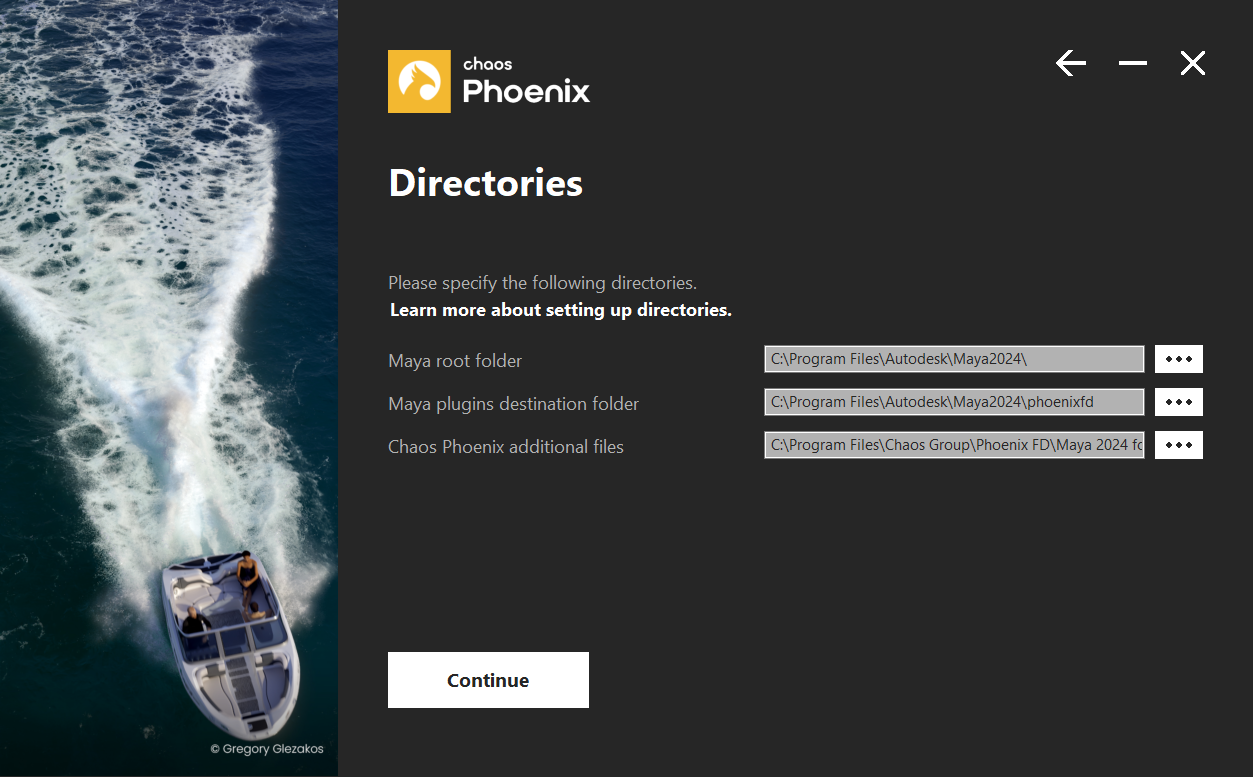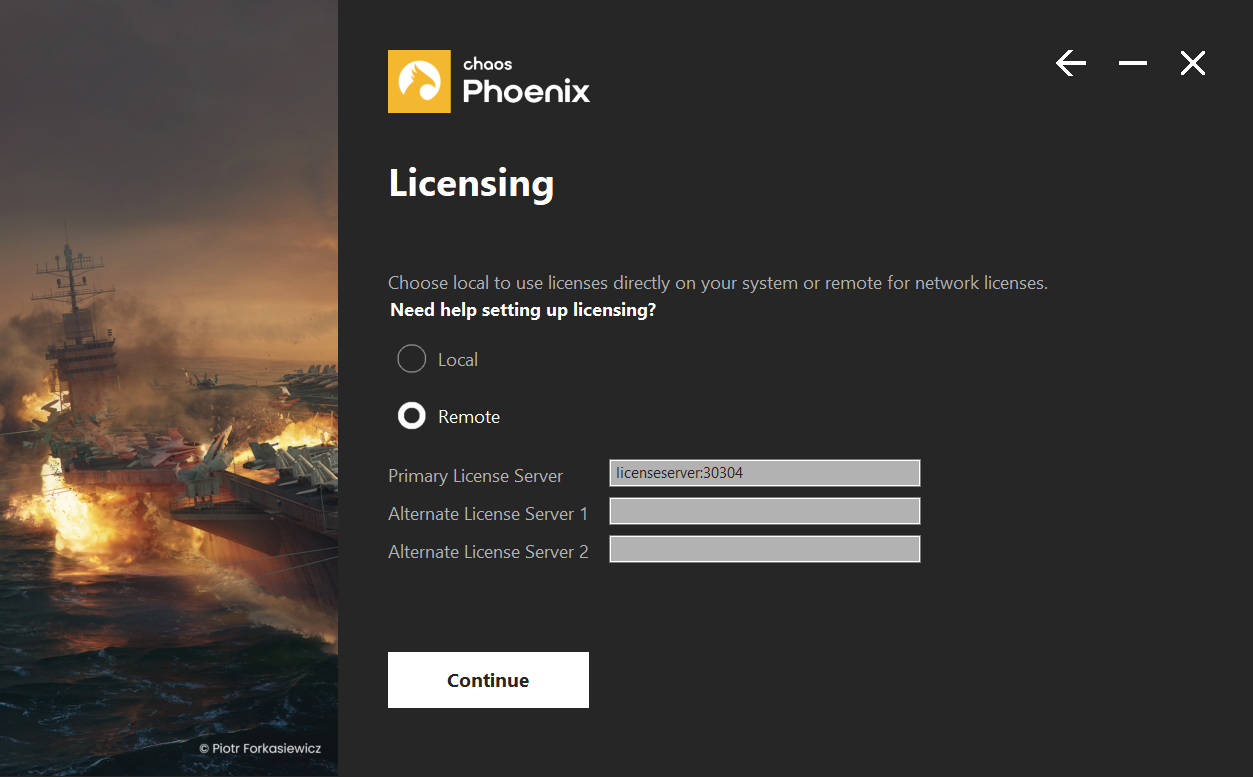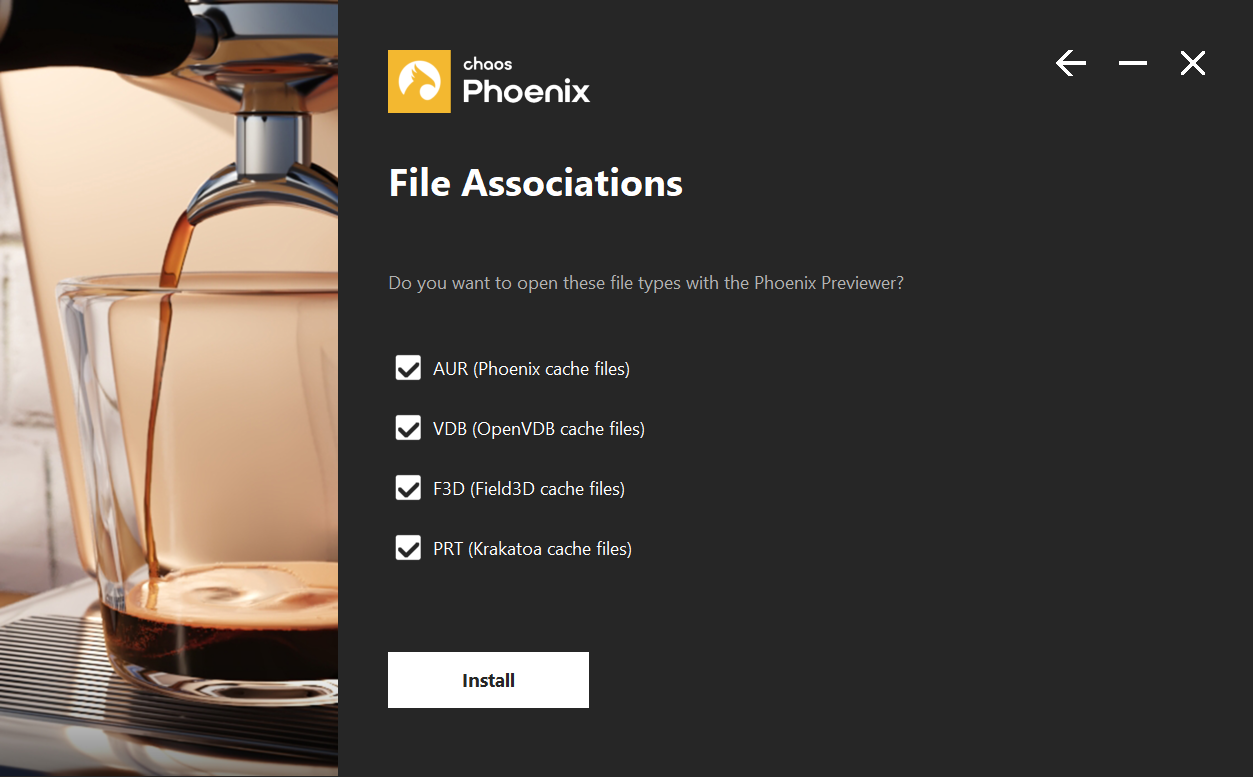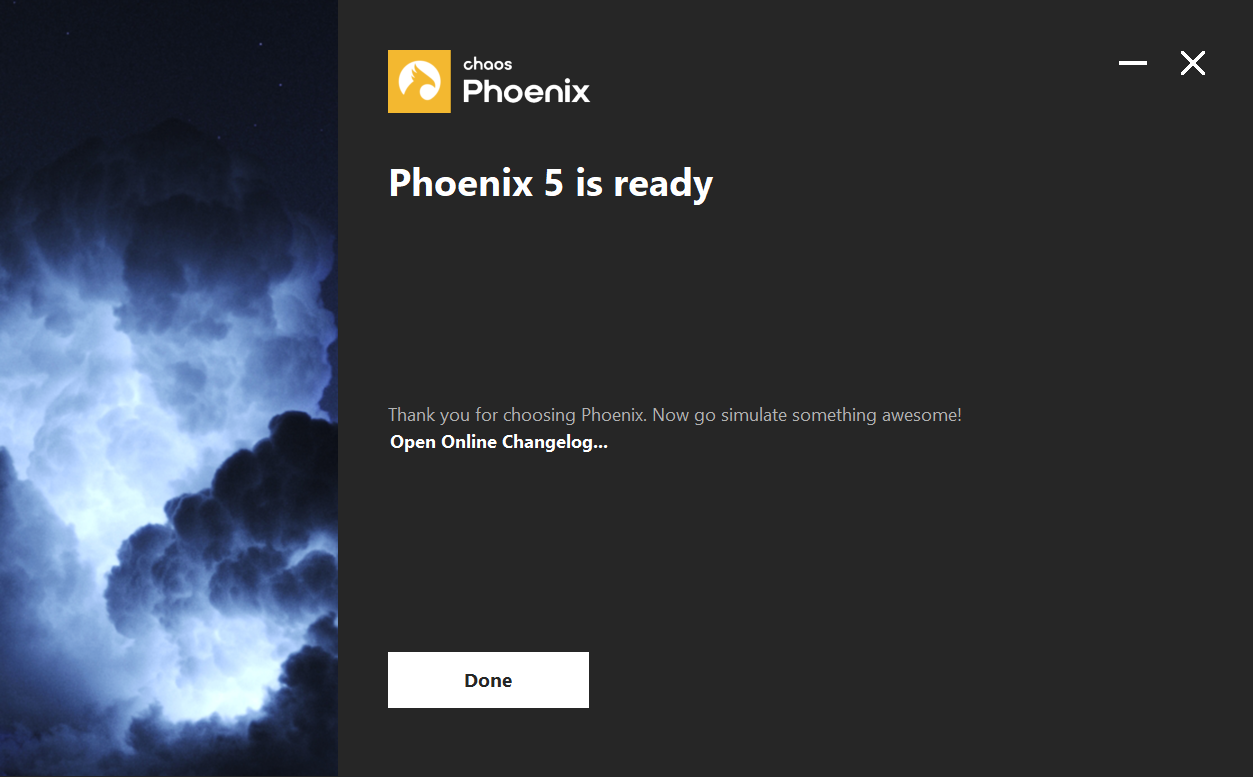Page History
This page provides an overview on setting up and installing Chaos Phoenix.
| Section | ||||||||||||||||||||
|---|---|---|---|---|---|---|---|---|---|---|---|---|---|---|---|---|---|---|---|---|
|
Overview
...
This guide serves as a reference for the installation of Phoenix FD 3.0 for Maya. You can download the latest official version of Phoenix FD 3.0 from http://www.chaosgroup.com with the account supplied to you by Chaos Group or your reseller.
This page covers installation of Phoenix FD through the Phoenix installer. For additional setup and troubleshooting, see the following pages:
| Fancy Bullets | ||
|---|---|---|
| ||
|
...
If you experience any problems, please check the Installation Troubleshooting page.
...
| UI Text Box | ||
|---|---|---|
|
In order to run Phoenix FD for Maya, you need to have V-Ray for Maya and access to the License Server (installed on your machine or a connection to one over your network). |
...
. |
System requirements
...
Please make sure that your system fulfills these requirements before installing Phoenix FD. Note that Phoenix FD is only supported for 64 bit operating systems and 64 bit versions of Maya.
| UI Text Box | ||
|---|---|---|
| ||
Phoenix for Maya comes in 3 build types - compatible with V-Ray 6, V-Ray 5 and V-Ray Next. If you don't have V-Ray, it does not matter at all which one you install - Phoenix would still be able to simulate, load, save and preview caches. If you do have V-Ray 6, V-Ray 5 or V-Ray Next, please take care to install a matching Phoenix build. Note that reading textures during simulation, e.g. by Sources, Mappers, etc., would be faster if you also have V-Ray installed. |
Windows
...
| Processor | Intel® Pentium ® IV or compatible processor with SSE4.2 support. | ||
| RAM | 8 GB RAM and 8 GB swap minimum – recommended 32 GB or more RAM, 32 GB or more swap file | ||
| Operating system | Windows ® 7 SP1, Windows ® 8.1 and Windows ® 10 Professional; | V-Ray for Maya | Phoenix for vray3 requires V-Ray 3.6 or later; Phoenix for vray4 requires V-Ray Next 4.0 or later, 64-bit versions only |
| Maya | Maya 2019 or later | ||
| USB port | Required for dongle licensing, USB 2.0 or newer | ||
| TCP/IP | Only IPv4 is supported. IPv6 is currently not supported | .||
| Chaos License Server | 4.5.1 or later |
The following table shows the versions of Autodesk Maya and operating systems on which V-Ray is supported. Note that V-Ray is only supported for 64 bit operating systems and 64 bit versions of Maya.
...
| V-Ray | V-Ray 6, all V-Ray 5 and V-Ray Next versions are supported |
Linux
...
| Processor | Intel ® Pentium ® IV or compatible processor with SSE4.2 support. | ||
| RAM | 8 GB RAM and 8 GB swap minimum – recommended 32 GB or more RAM, 32 GB or more swap file | ||
| Operating system | Red Hat ® Enterprise Linux® 6.5 and 7.2 WS, or CentOS 7.2 for all Maya versions; | V-Ray for Maya | V-Ray for Maya 3.6 or later, 64-bit versions only |
| Maya | Maya 2019 or later | ||
| USB port | Required for dongle licensing, USB 2.0 or newer | ||
| TCP/IP | Only IPv4 is supported. IPv6 is currently not supported. |
The following table shows the versions of Autodesk Maya and operating systems on which V-Ray is supported. Note that V-Ray is only supported for 64 bit operating systems and 64 bit versions of Maya.
...
| Chaos License Server | 4.5.1 or later |
| V-Ray | V-Ray 6, all V-Ray 5 versions are supported. Oldest supported V-Ray Next is Update 1 |
macOS
...
Processor | 1st Gen Intel® Core™ or compatible processor with SSE4.2 support (x64) |
| RAM | 8 GB RAM and 8 GB swap minimum – recommended 32 GB or more RAM, 32 GB or more swap file |
| Maya | Maya 2019 or later |
| Operating System | Apple ® macOS ® 12.x,11.x, 10.15.x, 10.14.x, 10.13.x, 10.12, 10.11.x |
| USB Port | Required for hardware lock, preferably USB 2.0 |
| TCP/IP | Only IPv4 is supported. IPv6 is currently not supported |
| V-Ray | V-Ray 6 and all V-Ray 5 versions are supported. |
...
Hardware Advice for Faster Simulating
...
| Hardware | Recommendation |
|---|---|
| Bus speed | Phoenix transfers huge amounts of data between memory and the CPU. The entire simulation grid gets processed tens to hundred times per simulation step, so the bus speed is the bottleneck in most simulations. |
| CPU speed | Processor speed is more important than core count. Also, NUMA and multiprocessor architectures do not perform well with Phoenix. Simulating on one NUMA node is often faster than waiting for multiple nodes to synchronize. |
| Fast Storage | Both large and small simulations take significant time just to write the cache files from the simulation and to read them back for the preview, so good storage speed can help decrease simulation times up to 30%. Turning off the preview for all grid and particle channels during large simulations could also help speed up the simulation. |
| GPU | GPUs are currently only used for the GPU preview of fire/smoke simulations. |
Software Advice for Faster Simulating
...
On some machines, the Anti-Virus software may treat Phoenix FD's files .aur, .f3d and .vdb as a potential risk and consume significant processing power to scan them. Since cache files are often hundreds of Megabytes or more, this could cause the simulation to slow down several times.
Consider adding an exception in your Anti-Virus software for these file formats.
You may also add Phoenix FD log file extension (.log) or the log file directory (accessible through the Phoenix Preferences) to the exceptions of the Anti-Virus software.
...
Here is a short step by step guide by Microsoft on Adding an Exclusion for Windows Defender.
| Anchor | ||||
|---|---|---|---|---|
|
...
Phoenix
...
| UI Text Box | ||
|---|---|---|
| ||
If you plan to render your Phoenix simulations with V-Ray, and V-Ray is currently not installed on your machine, please make sure to first run the V-Ray installer before running the Phoenix installer. |
The Phoenix FD installer will automatically remove any previous installations. This will allow you to seamlessly upgrade from older versions of Phoenix FD. If you experience problems, you can manually uninstall the previous versions to perform a clean install. For more information, please refer to the the Uninstalling Phoenix FD page page.
Before running the installation, make sure your Windows account has administrative privileges and the dongle is not plugged in.
Windows
...
Run the installer.
1.
...
Upon the start of the installation, Windows may ask you for permission to run the installer with administrator privileges. Please confirm.
2. You will be presented with the Phoenix
...
Licensing Agreements. Please take a moment to review the agreements. Click the I
...
accept the Agreement button to proceed
...
.
3.
...
If you press the Advanced button during the next step, you
...
will see the full list of customizable settings:
Directories – Please check if the default folders are correct. Common settings for an installation for Maya 2023 with default paths should look like the screenshot below.
Learn more about setting up directories – Will open a new browser window/tab to the Phoenix for Maya Setup and Installation page.
| Section | ||||||||||||||
|---|---|---|---|---|---|---|---|---|---|---|---|---|---|---|
|
...
|
4.
...
Uninstall previous installations – Leave this checked to automatically uninstall any previous versions.
Phoenix FD License Server location – If changed from Local Phoenix FD license server to Remote Phenix FD license server, additional settings become available in the window to set the server name/location.
...
Licensing – Specifies whether the Chaos License Server will run locally or on another machine.
Need help setting up licensing? – Will open a new browser window/tab to the Phoenix for Maya documentation page.
If you select the Remote option, you will have to fill in the IP address of your Chaos License Server in the field labeled Primary License Server. Please leave the port 30304 unchanged.
| Section | |||||||||||||||
|---|---|---|---|---|---|---|---|---|---|---|---|---|---|---|---|
|
5. File Associations – The selected file types will be associated and opened by default with the Phoenix Standalone Previewer.
| Section | |||||||||||||||
|---|---|---|---|---|---|---|---|---|---|---|---|---|---|---|---|
|
6. When ready, click the Install button.
5. When ready, click the Install Now button.
Linux
...
1. Unpack the contents of the installation archive to a temporary folder (called phoenix_install_dir below)
...
.
2. Open a console and navigate to that folder
...
.
3. Make sure you have root permissions or use the su or the sudo command and run the installation file in the directory for the respective OS and Maya version
...
.
4. Follow the instructions of the installer.
5. You will be presented with the License Agreement. Please take a few minutes to review it and then continue.
6.
...
Finish the installation.
| UI Text Box | |
|---|---|
|
...
Workstation (full) – Includes the Phoenix FD for Maya and sample scenes.
Render slave – Includes the Phoenix FD plugin for V-Ray Standalone. Pick this option if this machine is going to be used as a render slave only.
...
| ||
For example: $ cd phoenix_install_dir 50000_ maya2018maya2023_ vray_30_linux_x64vray5_centos7 |
Completing the installation
...
the
...
installation
...
...
1. After you click the Install
...
button, the installer will proceed to uninstall any previous versions and install Phoenix
...
on your machine.
2. If the installation was successful, you will
...
get the screen shown in the screenshot below.
Open Online Changelog – Will open the text file with changes broken down by releases (also available through the Version Change Logs).
3. Click the
...
Done button.
| Section | |||||||||||||||
|---|---|---|---|---|---|---|---|---|---|---|---|---|---|---|---|
|
3. If you don't already have a ChaosGroup License Server installed on your machine or if you have an older version, you should install the one included with the zip package of Phoenix for Maya (vrlservice_installer.exe or vrlservice_installer.bin for Linux), or download the latest License Sever from chaosgroup.com. To make sure that your license server is up and running and you have the necessary licenses, please proceed to the Set Up Your Phoenix FD License page.
Simulation Slaves and V-Ray Licenses
Running Phoenix FD simulations without rendering will still consume a V-Ray license for reading textures for the simulation. This can be turned off from the Phoenix Preferences (it's on by default), which can be found in the Phoenix menu, but it will make the sampling of textures a lot slower. However, this would be a way for machines that are only used as simulation slaves to assist in calculating sims and would not consume V-Ray licenses unless actually rendering.




